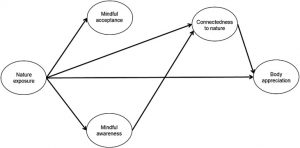Yoga and Other Exercises Improve Body Image and Psychological Well-Being
By John M. de Castro, Ph.D.
“Overall, practicing yoga can have a profound impact on improving body image, but it depends how it is approached by the individual. When you treat yoga as a tool for body appreciation, healthy movement, and inner reflection, it helps improve body image and mental health.” – Tara Caguait
The media is constantly presenting idealized images of what we should look like. These are unrealistic and unattainable for the vast majority of people. But it results in most everyone being unhappy with their body. This can lead to problematic consequences. In a number of eating disorders there’s a distorted body image. This can and does drive unhealthy behaviors. As a treatment mindfulness has been shown to improve eating disorders.
In the media, yoga is portrayed as practiced by lithe beautiful people. This is, of course, unrealistic and potentially harmful. But yoga is also an exercise that tends to improve the body and it has been shown to improve body image and psychological health. It is unclear whether it is the exercise provided by yoga practice that promotes psychological health and a healthy body image or to components specific to yoga practice.
In today’s Research News article “Yoga, Dance, Team Sports, or Individual Sports: Does the Type of Exercise Matter? An Online Study Investigating the Relationships Between Different Types of Exercise, Body Image, and Well-Being in Regular Exercise Practitioners.” (See summary below or view the full text of the study at: https://www.frontiersin.org/articles/10.3389/fpsyg.2021.621272/full?utm_source=F-AAE&utm_medium=EMLF&utm_campaign=MRK_1616048_69_Psycho_20210504_arts_A ) Marshin and colleagues recruited adults online and had them complete measures of amount and type of exercise, body size, body image, body dissatisfaction, eating disorders, physical efficacy, physical activity, positive and negative emotions, and depression.
They found that the participants who engaged in regular exercise had significantly lower body dissatisfaction, perceived body weight, and depression and significantly higher positive emotions than sedentary individuals. They also found that there were no significant differences in any of the outcome variables for regular exercise practitioners of yoga, ballroom dance, team sports, or individual sports.
These findings are correlational, so no conclusions can be reached regarding causation. But it is clear that people who exercise have a better image of their bodies and better mental health than sedentary individuals. The fact that there were no significant differences between practitioners of different types of exercise including yoga suggests that exercise of any type is associated with greater satisfaction with the body and better mood. Yoga practice has been shown to improve body image and positive emotions and lower depression. The present findings suggest that these benefits of yoga practice are due to the exercise and not to the other components of yoga practice.
So, yoga and other exercises improve body image and psychological well-being.
“Individuals who are dissatisfied with their body image are at a higher risk for eating disorders, depression, and low self-esteem. When diversity and inclusivity are encouraged, yoga may have an important role to play in supporting healthy feelings toward body image.” – Lacey Gibson
CMCS – Center for Mindfulness and Contemplative Studies
This and other Contemplative Studies posts are also available on Google+ https://plus.google.com/106784388191201299496/posts and on Twitter @MindfulResearch
Study Summary
Marschin V and Herbert C (2021) Yoga, Dance, Team Sports, or Individual Sports: Does the Type of Exercise Matter? An Online Study Investigating the Relationships Between Different Types of Exercise, Body Image, and Well-Being in Regular Exercise Practitioners. Front. Psychol. 12:621272. doi: 10.3389/fpsyg.2021.621272
Physical activity, specifically exercising, has been suggested to improve body image, mental health, and well-being. With respect to body image, previous findings highlight a general benefit of exercise. This study investigates whether the relationship between exercising and body image varies with the type of exercise that individuals preferentially and regularly engage in. In addition, physical efficacy was explored as a potential psychological mediator between type of exercise and body image. Using a cross-sectional design, healthy regular exercise practitioners of yoga, ballroom dance, team sports, or individual sports as well as healthy adults reporting no regular exercising were surveyed. Body image and its different facets were assessed by a set of standardized self-report questionnaires, covering perceptual, cognitive, and affective body image dimensions particularly related to negative body image. In addition, participants were questioned with regard to mental health. Participants were 270 healthy adults. Descriptive statistics, measures of variance (ANOVA), and multiple linear regression analysis with orthogonal contrasts were performed to investigate differences between the different exercise and non-exercise groups in the variables of interest. In line with the hypotheses and previous findings, the statistic comparisons revealed that body dissatisfaction (as one important factor of negative body image) was most pronounced in the non-exercise group compared to all exercise groups [contrast: no exercise versus exercise (all groups taken together)]. Physical efficacy, as assessed with a standardized questionnaire, mediated the difference between type of exercise (using contrasts) and body image including perceptual, cognitive, and affective body image dimensions. The findings shed light on so far less systematically investigated questions regarding the relationship between types of exercise, like yoga and ballroom dance, and body image. The results underscore the relevance of considering possible influencing factors in exercise research, such as the perception of one’s physical efficacy as a mediator of this relationship.


